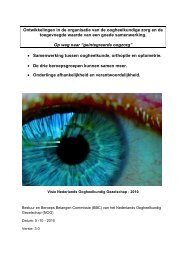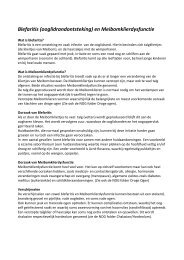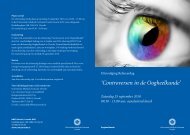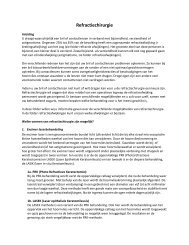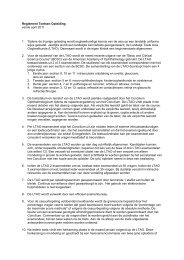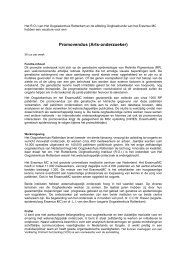terminology and guidelines for glaucoma ii - Kwaliteitskoepel
terminology and guidelines for glaucoma ii - Kwaliteitskoepel
terminology and guidelines for glaucoma ii - Kwaliteitskoepel
Create successful ePaper yourself
Turn your PDF publications into a flip-book with our unique Google optimized e-Paper software.
Furthermore, blindness may occur despite treatment <strong>and</strong> individuals at appreciable risk of visual disability thus needing<br />
rigorous management must to be identified. Consequently, physicians should be advised to consider more<br />
aggressive treatment of IOP in patients suspected to have altered ocular blood flow 13 . In some patients, arterial hypotension,<br />
either drug-induced or spontaneous, is a factor to be addressed with the internist.<br />
Neuroprotection refers to the concept of protecting ganglion cells from early death due to endo- or exotoxins or<br />
ischemia. Several experimental studies show the potential <strong>for</strong> this type of treatment in animal models on injury or in<br />
vitro. This research does not yet apply to humans. Large clinical trials are under way <strong>and</strong> results will be avaiable<br />
within 2-3 years.<br />
A large proportion of patients with progressive <strong>glaucoma</strong> still remain undiagnosed until too late. To discover<br />
<strong>and</strong> treat those at risk of losing functionally significant vision is a more preferable task than widespread treatment<br />
of IOP per se.<br />
It is important when selecting the medical treatment of <strong>glaucoma</strong> to underst<strong>and</strong> not only the aims of therapy, but<br />
also the mode of action, side effects <strong>and</strong> contraindications of each individual medication.<br />
There are many anti<strong>glaucoma</strong> drugs available. The choice of therapy must take into account quality of life, cost <strong>and</strong><br />
compliance. Generally speaking, if more than two topical medications are required to control the IOP, then other<br />
<strong>for</strong>ms of therapy, such as laser trabeculoplasty or surgery, should be considered.<br />
In many patients beta-blockers have been used as the first choice of therapy since they are effective <strong>and</strong> usually well<br />
tolerated. Caution must be exercised if the patient suffers from a systemic condition such as bronchopulmonary<br />
disease or cardiac arhythmia, since the systemic absorption of these drugs may cause relevant adverse systemic<br />
effects. If the first choice medication alone does not control the <strong>glaucoma</strong>, then adjunctive therapy can be added to<br />
the therapeutic regime. In any patient in whom topical beta-blockers are not indicated, any of the other topical<br />
agents can be initiated as first time therapy. Some relevant findings of the r<strong>and</strong>omized controlled trials are summarized<br />
in Ch. Introduction II.<br />
The following pages outline the most frequently used anti-<strong>glaucoma</strong> medications, <strong>and</strong> emphasize their mode of<br />
action, dosage <strong>and</strong> side effects. They are to be considered as a general guide, <strong>and</strong> cannot be all-inclusive.<br />
Ch. 3 - 4 EGS



